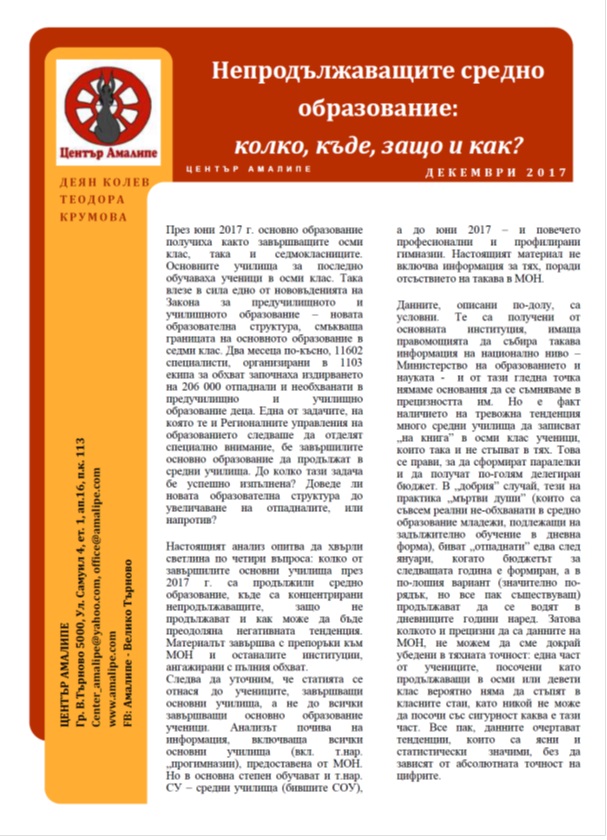11.12.2017The students who do not continue their secondary education: how many, where, why and how

In June 2017, both eighth and seventh graders received primary education. Primary schools trained students in eighth grade for the last time. Thus, one of the innovations of the Preschool and School Education Act has come into force - the new educational structure that cuts the boundary of primary education to the seventh grade. Two months later, 11602 specialists, organized in 1103 teams, began searching for 206,000 dropouts and children out of the scope of pre-school and school education. One of the tasks to which those teams and the Regional Governments of Education had to pay special attention was that graduates of primary education continue in secondary schools. How much did this task succeed? Has the new educational structure brought an increase in dropouts, or on the contrary?
This analysis attempts to clarify four questions: how many of the graduates of primary schools in 2017 have continued their secondary education, where they are concentrated, why they do not continue, and how the negative trend can be overcome. The material ends with recommendations to the Ministry of Education and Science and the other institutions involved in the full scope of students.
We should point out that the article refers to pupils completing primary schools and not to all pupils in primary education. The analysis is based on information including all primary schools (including "junior high schools") provided by the Ministry of Education and Science.
The data described below is conditional. It is a disturbing tendency for many high schools to record "on a book" students in eighth grade, who never enter the classrooms. This is done to form classes and get a larger delegated budget. Therefore, we can not be convinced of their unlimited accuracy: a part of the students mentioned as continuing in the eighth or ninth grade will probably not enter the classrooms. However, the data outlines trends that are clear and statistically significant, without depending on the absolute accuracy of figures.
The main trends
Analysis of the data for pupils enrolled in September 2017 in secondary schools who completed primary schools (7th or 8th grade) during the school year 2016/17 outlines the following trends:
1. Thousands of students drop out after completing primary education, becoming the largest group of dropouts
A total of 2763 students out of 42221 graduated in primary schools are not enrolled in secondary or high schools, which is about 6,33%. It should be pointed out that, according to NSI data from previous years, school drop-outs in the pre-crisis phase are between 3 and 4% per year. From this point of view, 6.33% non-continuing in the first high school stage seems terrifying.
After completion of the 7th grade, 4,56% of the students graduated in primary schools did not continue (1319 out of 28,963). The percentage is significantly higher after completing 8th grade - 10.19% (1354 out of 13285), the number being quite similar, almost identical.
2. The presence / absence of a secondary school in the respective locality is an important statistically significant factor that affects the enrollment in secondary education.
The percentage of non-enrolled elementary school pupils who are the only ones in their respective location is almost doubled: 8.97% compared to 5.03% of the primary school graduates in the cities.
3. The creation of unified schools is an effective means of minimizing drop-out after seventh grade: Fifty-five primary schools have been transformed into unified of the new school year 2017/18. Most of them are in rural areas - 48, five are in urban areas, and two are in the capital.
4. Drop-out students are not evenly distributed across schools and regions, and there is concentration and even overconcentration in certain municipalities and schools.
Possible solutions
The enrollment and completion of at least the first high school stage of all pupils who have completed primary education is imperative. Not only because they are at compulsory education age, but also because the Bulgarian economy needs a skilled workforce. The presence of thousands of pupils who drop out after graduating primary education is a negative trend over which comprehensive measures need to be taken. This analysis focuses on several of those measures:
1. Transformation of primary schools that are unique in the settlement into unified, can minimize the non-continuing in the first high school stage in rural areas.
The presence of dozens of rural schools with over-concentration of non-continuing students is a prerequisite for expanding the number of unified schools. MES should make a purposeful analysis of where the mainstream schools are transformed into unified and support this process.
2. Desegregation of segregated Roma schools in big towns: The investment in desegregation, in measures to stimulate training in ethnically mixed schools after completing an initial stage or basic education is not only strategically correct but also more effective;
3. A resource for enhancing the scope and improving the quality of education in schools with concentration and over-concentration of drop-outs.
4. National Program for Work with Parents: Undoubtedly, parents are a key factor in the continuation or non-continuation of students in secondary schools. It is important for schools in rural areas to implement activities to increase the capacity and support of parents for the education of their children. It is appropriate to involve non-governmental organizations working with local communities and educational mediators.
5. The Ministry of Education should continue and expand its support to overcome the financial barriers faced by high school students: free transportation from the villages to the chosen high school, free textbooks for the secondary school students in need, etc.








